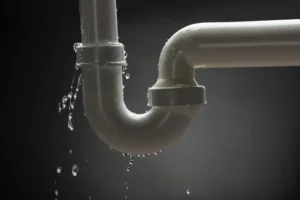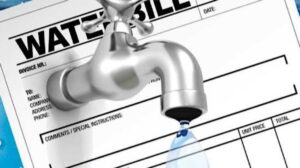How to Spot a Hidden Water Leak in Your Home
Protect your home from costly damage with early leak detection.
Water is essential for everyday living — but when it ends up in the wrong place, it can quickly become one of your home’s most destructive forces. While some plumbing issues are obvious (a dripping faucet or a flooded basement), others hide quietly behind walls, under floors, or in ceilings, causing thousands of dollars in damage before you even know they’re there.
At Northern Plumbing Company, we’ve seen how hidden water leaks can wreak havoc on homes when left undetected. This article will help you understand how to recognize the signs of a hidden leak, where they commonly occur, and what to do if you suspect one in your home.

Why Hidden Leaks Are So Dangerous
Unlike visible leaks that drip from your faucet or puddle beneath your sink, hidden leaks can go undetected for weeks — or even months. Over time, they can:
-
Weaken structural components like wood framing, drywall, and subflooring
-
Promote mold and mildew growth, which can trigger allergies or respiratory issues
-
Damage electrical systems and increase fire risk
-
Drive up your water bills, costing you hundreds each year
-
Devalue your property due to long-term damage or insurance claims
The key to avoiding major headaches is early detection.
7 Warning Signs of a Hidden Water Leak
1. Sudden Increase in Water Bills
One of the first clues many homeowners notice is an unexpected jump in their water bill. If your water usage habits haven’t changed, but your monthly charges have increased, that’s a strong indicator that water is escaping somewhere unseen.
Pro Tip: Track your water bills monthly. Spikes with no clear explanation should always be investigated.
2. Musty Smells or Damp Odors
If you notice a persistent damp, earthy, or musty smell — particularly in areas like basements, closets, or bathrooms — it may be due to mold or mildew caused by a hidden leak. Water trapped behind walls or under flooring creates the perfect environment for mold to grow.
3. Discolored or Stained Walls and Ceilings
Water leaking behind walls can cause paint to bubble or peel, and drywall may show yellowish-brown stains. Ceilings may sag or become soft to the touch. These are all signs that water is accumulating behind the surface and needs immediate attention.
4. Warped or Buckled Floors
Wood and laminate flooring are especially sensitive to moisture. If sections of your floor start to buckle, warp, or feel soft, there may be a leak below. In bathrooms or kitchens, pay close attention to flooring near sinks, tubs, or appliances.
5. Hearing Water When Nothing Is Running
Have you ever heard the sound of trickling or running water when all your faucets are turned off? This could be a sign of a pipe leaking behind walls or under the floor. Always investigate unexplained plumbing sounds.
6. Mold Spots on Walls or Baseboards
Visible mold — even in small patches — may mean a leak is nearby. Mold feeds on moisture, so if it’s appearing away from typical sources like showers or sinks, there could be water accumulating behind the surface.
7. Low Water Pressure in One or More Fixtures
If only one area of your home is experiencing poor water pressure, it could be a localized leak in the pipe leading to that fixture. Inconsistent or reduced water pressure often signals a leak before you see any visual signs.
Common Locations for Hidden Leaks
Knowing where leaks most commonly occur can help you narrow your search. Some frequent trouble spots include:
-
Behind shower or tub walls
-
Under bathroom or kitchen sinks
-
Beneath dishwashers and washing machines
-
In crawl spaces and basements
-
Behind water heaters or boilers
-
Under slab foundations (slab leaks)
-
Outdoor irrigation systems or hose bibs
If your home is older, or if you’ve recently had renovations or plumbing work done, the risk of leaks increases.
How to Test for a Leak: The Water Meter Test
If you suspect a leak but aren’t sure where it is, try this simple DIY test:
-
Turn off all water-using appliances and fixtures in your home.
-
Locate your water meter (usually in the basement or an outdoor box).
-
Take a reading, including the small dial if there is one.
-
Wait 1–2 hours without using any water.
-
Check the meter again.
If the number has changed, you likely have a leak — and it’s time to take action.
When to Call a Professional
While some leaks (like a loose pipe under the sink) are easy to fix, hidden leaks behind walls or under foundations require specialized tools and expertise. At Northern Plumbing Company, we use advanced leak detection technology such as:
-
Infrared thermal imaging
-
Acoustic listening devices
-
Video camera pipe inspections
-
Moisture sensors and scanners
These tools allow us to pinpoint the leak without tearing apart your home, saving you time, money, and stress.

How We Can Help
At Northern Plumbing Company, we’ve been helping homeowners identify and fix hidden water leaks for over years. Our licensed and insured technicians respond quickly, use non-invasive techniques, and get the job done right the first time.
We also offer:
-
24/7 emergency leak repair
-
Slab leak detection and repair
-
Water damage assessment and prevention
-
Comprehensive plumbing inspections
Don’t Ignore the Signs
A hidden water leak is not something you want to leave to chance. The longer it goes undetected, the more expensive the damage becomes — not just to your plumbing, but to your home’s structure, air quality, and value.
If you’ve noticed any of the warning signs above, don’t wait.
📞 Call Northern Plumbing Company
How to Spot a Hidden Water Leak in Your Home How to Spot a Hidden Water Leak in Your Home How to Spot a Hidden Water Leak in Your Home How to Spot a Hidden Water Leak in Your Home How to Spot a Hidden Water Leak in Your Home How to Spot a Hidden Water Leak in Your Home How to Spot a Hidden Water Leak in Your Home How to Spot a Hidden Water Leak in Your Home How to Spot a Hidden Water Leak in Your Home How to Spot a Hidden Water Leak in Your Home
</div hidden>



Pingback: Top Kitchen Plumbing Upgrades That Add Value to Your Home